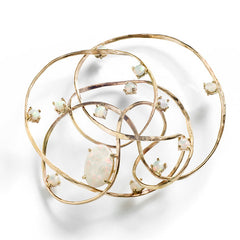 Did you know that opals, which is the birthstone of October and the star of this blog post, were once considered to bring bad luck? In the mid-1800s people believed that witches used them for witchcraft and they were themes in several novels, each time ruining the main character's life. Today, we know that all these myths surrounding this beautiful gem are nothing but made up stories. To wear an opal doesn't bring bad luck, even if you weren't born in October. Another myth is that opals have the ability to change their colors depending on one's mood...that is just untrue. The only reason the color seems to vary is due to changes in light. For centuries people believed that opals needed to be kept in water. However, today 95% of opals come from Australia and are formed in sandstone. This means Australian opals need little to no moisture and therefore should not be kept in water. Some opals that come from other parts of the world, such as Mexico, do however need moisture to stay beautiful.
Did you know that opals, which is the birthstone of October and the star of this blog post, were once considered to bring bad luck? In the mid-1800s people believed that witches used them for witchcraft and they were themes in several novels, each time ruining the main character's life. Today, we know that all these myths surrounding this beautiful gem are nothing but made up stories. To wear an opal doesn't bring bad luck, even if you weren't born in October. Another myth is that opals have the ability to change their colors depending on one's mood...that is just untrue. The only reason the color seems to vary is due to changes in light. For centuries people believed that opals needed to be kept in water. However, today 95% of opals come from Australia and are formed in sandstone. This means Australian opals need little to no moisture and therefore should not be kept in water. Some opals that come from other parts of the world, such as Mexico, do however need moisture to stay beautiful.
 The word opal comes from the Greek 'opallos', which means 'to see a change in color" and from the Latin word 'opalus', which means 'precious jewel'. Opals come in a wide range of colors, from a milky white to a dark black. Often these precious stones contain little flashes of other colors, which makes them seem very mysterious and out of this world. The opal only has a hardness of 6.5 on the Mohs Scale of Hardness, which means it breaks quite easily and tends to be brittle. If you want to keep your opal as beautiful as on the day you got it, make sure not to use any harsh cleaners and of course try not to bump it on a hard surface as it is more prone to break than many other stones.
The word opal comes from the Greek 'opallos', which means 'to see a change in color" and from the Latin word 'opalus', which means 'precious jewel'. Opals come in a wide range of colors, from a milky white to a dark black. Often these precious stones contain little flashes of other colors, which makes them seem very mysterious and out of this world. The opal only has a hardness of 6.5 on the Mohs Scale of Hardness, which means it breaks quite easily and tends to be brittle. If you want to keep your opal as beautiful as on the day you got it, make sure not to use any harsh cleaners and of course try not to bump it on a hard surface as it is more prone to break than many other stones.
Uncut Opal Photo Credit: Flickr.com - Striving to a goal
